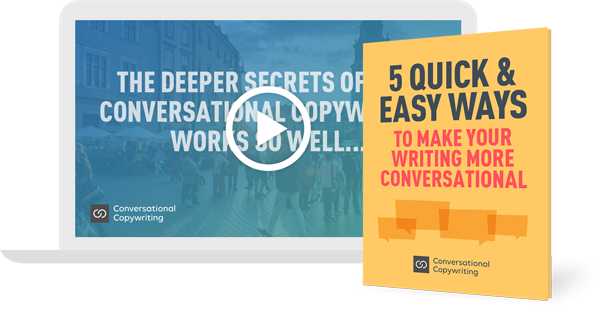
There’s something happening in the world of online copywriting.
I’m seeing more and more companies push the boundaries when it comes to honesty and transparency in marketing.
And I know many copywriters – some very experienced, and others just starting out – who feel very uncomfortable with being asked to mislead their readers with half-truths.
What’s happening here? Are we suddenly becoming more and more dishonest?
I don’t think so. But I do believe copywriters are finding themselves put on the spot by the rise of automation and analytics.
Automation creates distance between marketers and their audience…
As an online marketer it’s hard to ignore all the systems and services out there that optimize sign-ups through social media and email, create killer landing pages, and drive prospects into automated email sequences and sales funnels.
The whole process is now fully automated and optimized.
In fact, as a marketer, you may not see, hear from or interact with any of your prospects or customers.
All you see is numbers. Not people, but numbers.
When you’re disconnected from your audience in that way it can be incredibly easy to cross the line between being open and transparent to being dishonest and manipulative.
Being dishonest with someone face to face will make you feel bad. But being dishonest when all you see is a list of numbers is a whole lot easier.
Analytics tempt you to keep pushing the boundaries…
As copywriters we know there are tips and tricks we can use to increase sales.
We know how to tap into an audience’s fear of loss. We know how to appeal to their greed. We know how to use scarcity and deadlines to get people reaching for their credit cards. And so on.
Every copywriter has a toolbox of tricks and techniques to increase sales.
When I look back at the work of the copywriters I admired most when I was starting out 35 years ago, they all understood these techniques, but used them with a light touch.
Today I see the opposite. Not a light touch, but a heavy-handed onslaught.
Instead of these techniques being carefully integrated into well-crafted, persuasive copy… I see them being used as coarse, blunt instruments.
Why is this happening?
Again, in part it’s because of the anonymity that comes with automation. It’s easier to be pushy, blunt and even outright dishonest with someone when you’re not looking them in the eye.
But it’s also about the massive volume of data that comes out of the analysis of sales pages and email sequences.
These days we can test everything on the fly. We can see how every little tweak can increase conversions.
We can see how gently nudging an exaggeration into what is essentially a lie can increase sales by 10%.
In other words, the data keeps telling us to push the boundaries when it comes to being honest about what we’re selling.
But… that’s no way to build longer-term relationships.
The automated and data-driven marketing approach may increase sales today, but will eventually lead to audience fatigue.
Too many in-your-face promotions, too many last-chance emails, too much pushing, too much exaggeration and dishonesty.
People get tired of all that noise, and then they disengage.
And, because the marketer is also disengaged, behind that wall of automated systems and spreadsheets, he or she doesn’t even notice as customers start to grow weary and wander away.
The alternative? Honest engagement through conversation…
If a marketer wants to play the long game, and build a base of customers who are happy and ready to buy again – they need to take a different approach.
At the heart of this different approach lies the value of true engagement.
Don’t just sell AT your audience. Engage WITH your audience.
Step out from behind your monitor and all that data. Interact with your audience through social media, surveys, live Q&A sessions and so on.
And write to your audience in a way that is less one-way and less pushy. Step back from the temptation to sell through exaggeration and half-truths.
I’m not recommending you abandon all the benefits of marketing automation.
But I am suggesting you take a more conversational approach, look your readers in the eye, and tell the truth.
Never forget that your prospects and customers are people first and data points second!
To paraphrase legendary marketer David Ogilvy, “Your customer isn’t data. He’s your husband.”
NOTE: If you’d like to add the craft of conversational copywriting to your online writer’s toolbox, find out about the Conversational Copywriting course here…

Thank you for your insight Nick,
I fully agree. I just watched a couple of webinars which, at the end of the day, told me I could attract 10-20- even more clients by just following this automated course. Now I’m quite sure it might be ideal for small businesses wanting to grow, but really didn’t appeal to me. As I messaged to the trainer, I want a few GOOD clients as for me it’s one on one and I’m positive there type of system would wear me out in no time flat and leave me with no sense of satisfaction at all. Hilary
Automation isn’t the culprit … any tool can be abused. Heck, even email puts a barrier between people (albeit one we’re used to experiencing!) You could argue the only true conversation is face to face. You get all the “data” then – facial expressions, intonation, tempo and more. But it’s impractical for business to use on a large scale … although they’ve been using that format for years: they’re called “sales people” 😉 I agree with your overall point though, the technology does not a master make! And there is a fine line between abuse and appropriate application. Awesome article as always.
James, good to hear from you! : ) I think we more or less agree. A key problem, I think, is that as systems and “funnels” become more and more automated, marketers simply forget to insert themselves into the process as real people with real voices. I received an email recently that was actually written in a fairly conversational tone, but referenced the maximum character count for Twitter as being 140. This email just sits within the system somewhere, and nobody has thought to update it. All automation with diminishing levels of engagement.
No matter how much artificial intelligence is thrown at automated marketing don’t you think the audience can, at least unconsciously, see the missing human behind the promotion?
Additionally, as many marketers are using similar techniques, it gets harder and harder to use the 4 Us – especially “unique”. So, if you’ve run out of uniqueness, copywriters are pressured to start making up for that lack by bending the truth in pursuit of uniqueness!
Unless there are other ways of being unique and that’s where I think you are on the right track, Nick.